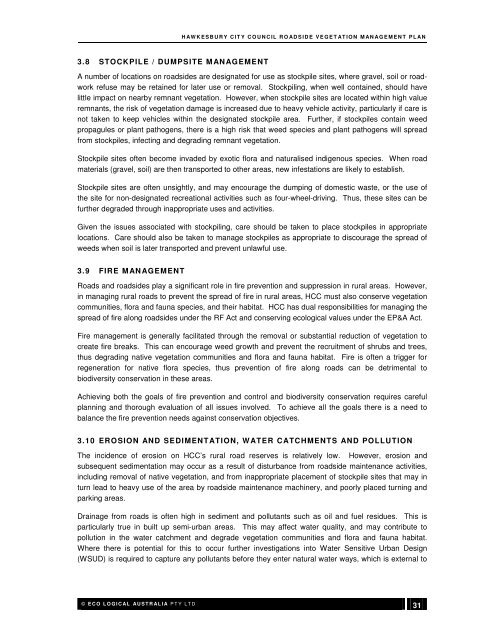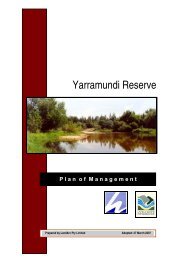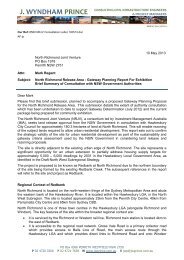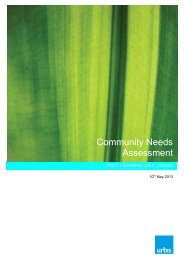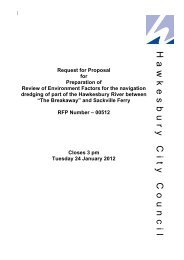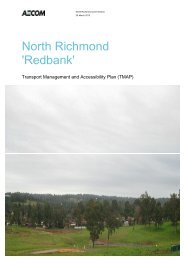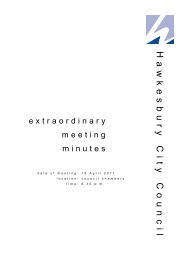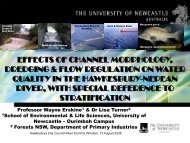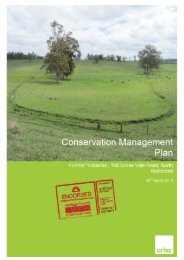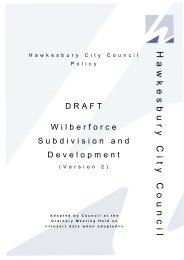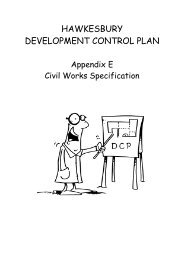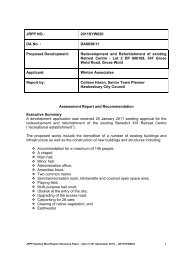Attachment 1 to Item 53 - Roadside Vegetation Management Plan
Attachment 1 to Item 53 - Roadside Vegetation Management Plan
Attachment 1 to Item 53 - Roadside Vegetation Management Plan
You also want an ePaper? Increase the reach of your titles
YUMPU automatically turns print PDFs into web optimized ePapers that Google loves.
H AW K E S B U R Y C IT Y C O U N C IL R O AD S ID E V E G E T AT IO N M AN AG E M E N T P L AN<br />
3.8 STOCKPILE / DUMPSITE M ANAGEMENT<br />
A number of locations on roadsides are designated for use as s<strong>to</strong>ckpile sites, where gravel, soil or roadwork<br />
refuse may be retained for later use or removal. S<strong>to</strong>ckpiling, when well contained, should have<br />
little impact on nearby remnant vegetation. However, when s<strong>to</strong>ckpile sites are located within high value<br />
remnants, the risk of vegetation damage is increased due <strong>to</strong> heavy vehicle activity, particularly if care is<br />
not taken <strong>to</strong> keep vehicles within the designated s<strong>to</strong>ckpile area. Further, if s<strong>to</strong>ckpiles contain weed<br />
propagules or plant pathogens, there is a high risk that weed species and plant pathogens will spread<br />
from s<strong>to</strong>ckpiles, infecting and degrading remnant vegetation.<br />
S<strong>to</strong>ckpile sites often become invaded by exotic flora and naturalised indigenous species. When road<br />
materials (gravel, soil) are then transported <strong>to</strong> other areas, new infestations are likely <strong>to</strong> establish.<br />
S<strong>to</strong>ckpile sites are often unsightly, and may encourage the dumping of domestic waste, or the use of<br />
the site for non-designated recreational activities such as four-wheel-driving. Thus, these sites can be<br />
further degraded through inappropriate uses and activities.<br />
Given the issues associated with s<strong>to</strong>ckpiling, care should be taken <strong>to</strong> place s<strong>to</strong>ckpiles in appropriate<br />
locations. Care should also be taken <strong>to</strong> manage s<strong>to</strong>ckpiles as appropriate <strong>to</strong> discourage the spread of<br />
weeds when soil is later transported and prevent unlawful use.<br />
3.9 FIRE MANAGEMENT<br />
Roads and roadsides play a significant role in fire prevention and suppression in rural areas. However,<br />
in managing rural roads <strong>to</strong> prevent the spread of fire in rural areas, HCC must also conserve vegetation<br />
communities, flora and fauna species, and their habitat. HCC has dual responsibilities for managing the<br />
spread of fire along roadsides under the RF Act and conserving ecological values under the EP&A Act.<br />
Fire management is generally facilitated through the removal or substantial reduction of vegetation <strong>to</strong><br />
create fire breaks. This can encourage weed growth and prevent the recruitment of shrubs and trees,<br />
thus degrading native vegetation communities and flora and fauna habitat. Fire is often a trigger for<br />
regeneration for native flora species, thus prevention of fire along roads can be detrimental <strong>to</strong><br />
biodiversity conservation in these areas.<br />
Achieving both the goals of fire prevention and control and biodiversity conservation requires careful<br />
planning and thorough evaluation of all issues involved. To achieve all the goals there is a need <strong>to</strong><br />
balance the fire prevention needs against conservation objectives.<br />
3.10 EROSION AND SEDIMENTATION, WATER CATCHMENTS AND POLLUTION<br />
The incidence of erosion on HCC’s rural road reserves is relatively low. However, erosion and<br />
subsequent sedimentation may occur as a result of disturbance from roadside maintenance activities,<br />
including removal of native vegetation, and from inappropriate placement of s<strong>to</strong>ckpile sites that may in<br />
turn lead <strong>to</strong> heavy use of the area by roadside maintenance machinery, and poorly placed turning and<br />
parking areas.<br />
Drainage from roads is often high in sediment and pollutants such as oil and fuel residues. This is<br />
particularly true in built up semi-urban areas. This may affect water quality, and may contribute <strong>to</strong><br />
pollution in the water catchment and degrade vegetation communities and flora and fauna habitat.<br />
Where there is potential for this <strong>to</strong> occur further investigations in<strong>to</strong> Water Sensitive Urban Design<br />
(WSUD) is required <strong>to</strong> capture any pollutants before they enter natural water ways, which is external <strong>to</strong><br />
© E C O L O G I C AL AU S T R AL I A P T Y L T D<br />
31


